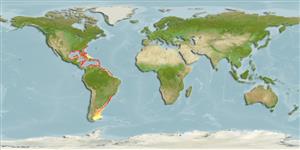Elasmobranchii (Haie und Rochen) (sharks and rays) >
Squaliformes (Sleeper and dogfish sharks) >
Squalidae (Dogfish sharks)
Etymology: Squalus: Genus name from Latin 'squalus' meaning shark (Ref. 6885, 27436).
Environment: milieu / climate zone / Tiefenbereich / distribution range
Ökologie
seewasser demersal; tiefenbereich 60 - 400 m (Ref. 247). Subtropical; 36°N - 56°S, 97°W - 45°W (Ref. 54893)
Western Atlantic: North Carolina to Florida (USA), Gulf of Mexico, Cuba, Hispaniola; southern Brazil and Argentina.
Size / Gewicht / Alter
Geschlechtsreife: Lm ? range ? - 50 cm
Max length : 110 cm TL Männchen/unbestimmt; (Ref. 247); common length : 75.0 cm TL Männchen/unbestimmt; (Ref. 247)
A slim, gray shark with tips of dorsal fins black and edges of pectoral, pelvic and caudal fins white; two dorsal fins each with strong, ungrooved spine at front edge (Ref. 26938).
Body shape (shape guide): elongated.
Inhabits continental shelves and uppermost slopes. Found in 60 to 380 m deep (Ref. 26938). Found on or near the bottom in large, dense schools. Probably feeds on bottom fishes and invertebrates. Ovoviviparous, with about 10 young per litter. A huge parasite (isopod) lives in its buccal cavity. Seldom used for food, but taken in commercial catches for its liver which yields oil and vitamins. Maximum depth reported taken from Ref. 55584.
Ovoviviparous, with about 10 young per litter (Ref. 247). Distinct pairing with embrace (Ref. 205).
Compagno, L.J.V., 1984. FAO Species Catalogue. Vol. 4. Sharks of the world. An annotated and illustrated catalogue of shark species known to date. Part 1 - Hexanchiformes to Lamniformes. FAO Fish. Synop. 125(4/1):1-249. Rome, FAO. (Ref. 247)
IUCN Rote Liste Status (Ref. 130435: Version 2025-1)
Bedrohung für Menschen
Harmless
Nutzung durch Menschen
Fischereien: weniger kommerziell
Tools
Zusatzinformationen
Download XML
Internet Quellen
Estimates based on models
Preferred temperature (Ref.
123201): 13.6 - 23.7, mean 18.7 °C (based on 111 cells).
Phylogenetic diversity index (Ref.
82804): PD
50 = 0.5000 [Uniqueness, from 0.5 = low to 2.0 = high].
Bayesian length-weight: a=0.00347 (0.00165 - 0.00730), b=3.09 (2.92 - 3.26), in cm total length, based on LWR estimates for this Genus-body shape (Ref.
93245).
Trophic level (Ref.
69278): 4.2 ±0.6 se; based on diet studies.
Widerstandsfähigkeit (Ref.
120179): sehr niedrig, Verdopplung der Population dauert mehr als 14 Jahre. (Fec=10).
Fishing Vulnerability (Ref.
59153): High to very high vulnerability (66 of 100).
🛈
